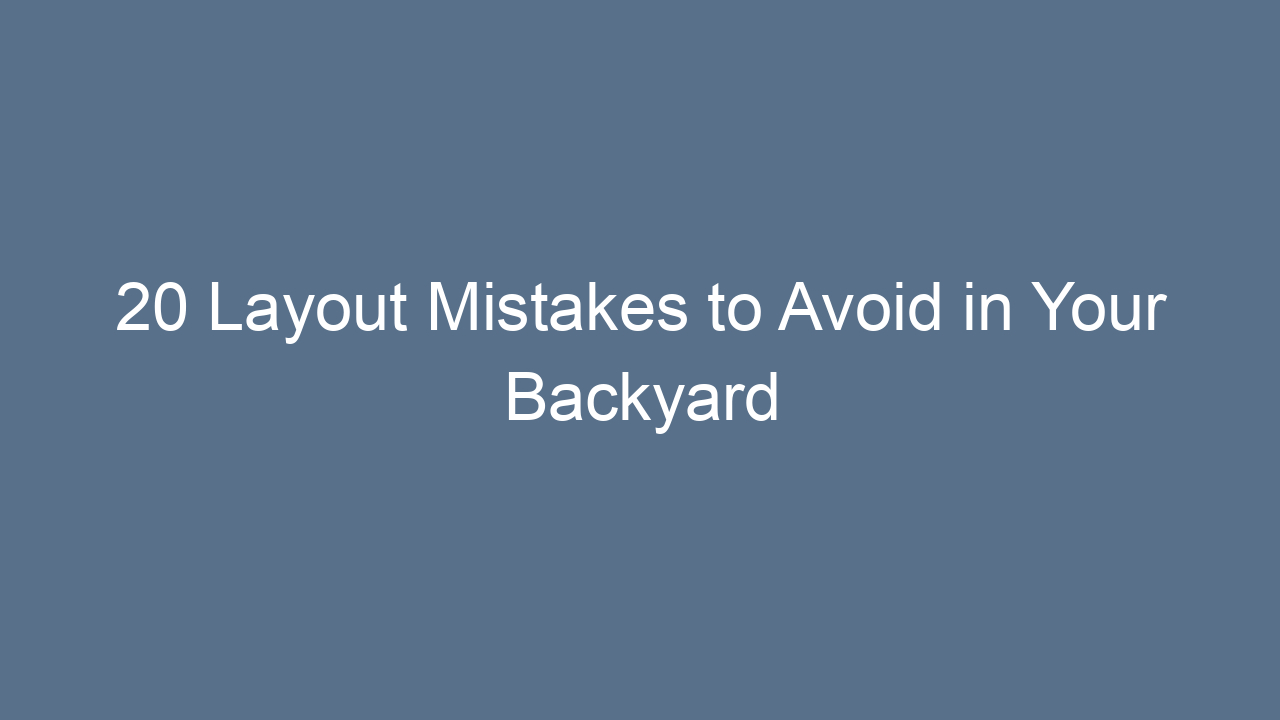20 Layout Mistakes to Avoid in Your Backyard Design

Designing a backyard can be exciting, like painting on a blank canvas. But it’s easy to make mistakes that can turn your dream outdoor space into a frustrating maze of poor layouts and wasted potential. Your backyard should feel like an extension of your home—a place to relax, entertain, and enjoy nature. Yet, many homeowners unknowingly commit design blunders that compromise both functionality and aesthetics. In this article, we’ll explore 20 layout mistakes to avoid in your backyard design so you can create a space that is both beautiful and practical.
Whether you have a sprawling garden or a small urban backyard, these insights will guide you toward a layout that works effortlessly for your lifestyle.
In This Article
- 1 1. Ignoring the Flow of Movement
- 2 2. Overcrowding the Space
- 3 3. Ignoring Sun and Shade Patterns
- 4 4. Not Planning for Privacy
- 5 5. Focusing Only on Aesthetics
- 6 6. Overlooking Scale and Proportion
- 7 7. Neglecting Focal Points
- 8 8. Forgetting Seasonal Considerations
- 9 9. Poorly Planned Lighting
- 10 10. Skipping Storage Solutions
- 11 11. Ignoring Drainage and Slope
- 12 12. Using Inappropriate Materials
- 13 13. Forgetting to Define Zones
- 14 14. Overcomplicating the Design
- 15 15. Not Considering Outdoor Furniture Placement
- 16 16. Underestimating Maintenance Needs
- 17 17. Overlooking Environmental Impact
- 18 18. Forgetting About Pets and Kids
- 19 19. Ignoring the View from Indoors
- 20 20. Skipping a Long-Term Plan
1. Ignoring the Flow of Movement
One of the most common mistakes in backyard design is neglecting the natural flow of movement. People often cram elements together without considering how they will walk or move around the space. A poorly planned path can make your backyard feel cramped and frustrating to navigate. Always think about how family members, guests, and even pets will move through the area. Design pathways that connect the main zones—like seating areas, gardens, and fire pits—without creating bottlenecks or awkward corners. Remember, your backyard should invite exploration, not confusion. Simple stepping stones or gravel paths can make a huge difference in guiding movement naturally.
2. Overcrowding the Space
Many homeowners want to include every trendy backyard feature, from pergolas to fountains, but too many elements can make the yard feel chaotic. Overcrowding reduces usable space and prevents each element from shining. Instead, prioritize features that truly matter to your lifestyle. For instance, if you love hosting barbecues, focus on a well-placed grill, dining area, and lounge zone, rather than filling the yard with unnecessary decor. Negative space, or open areas, is just as important as functional zones—it allows for flexibility and ensures your backyard feels breathable and inviting.
3. Ignoring Sun and Shade Patterns
Designing a backyard without considering sun and shade can turn your relaxing haven into an uncomfortable spot. Morning sun, afternoon heat, and evening shade all influence how you can use different areas. Planting a sun-loving garden in a shaded corner or placing your dining table under harsh midday sun will reduce usability. Observe your yard throughout the day to understand light patterns. Use shade structures like pergolas, umbrellas, or strategically planted trees to create balance. This will ensure you have pleasant spots for every time of day.
4. Not Planning for Privacy
Privacy is essential for comfort and peace in your backyard. Placing your seating area too close to neighbors or public paths can feel intrusive. Avoid this mistake by incorporating fences, tall hedges, or lattice screens. Even a small visual barrier can create a sense of seclusion. For example, a corner seating nook surrounded by shrubs not only adds greenery but also provides an intimate area for relaxation. Your backyard should feel like your private sanctuary, not an extension of the neighborhood sidewalk.
5. Focusing Only on Aesthetics
While beauty is important, prioritizing aesthetics over function can backfire. Stunning features like oversized fountains or intricate sculptures are eye-catching but may take up valuable space or block pathways. Balance is key. Always ask yourself: “Does this element serve a practical purpose?” Functionality includes seating, storage, and ease of maintenance. A backyard should be both a feast for the eyes and a comfortable space to live in. Beautiful but unusable spaces can quickly become frustrating rather than relaxing.
6. Overlooking Scale and Proportion
Many backyard design mistakes come from ignoring scale. A tiny patio with an oversized table or a small garden overshadowed by a giant tree creates visual imbalance. Every element should complement the size of your yard and each other. Use proportional furniture, lighting, and structures to create harmony. Visual balance not only looks good but also improves usability. Before buying features, measure your space and mock up layouts to avoid regrets later.
7. Neglecting Focal Points
Every backyard needs a focal point—a visual anchor that draws attention and provides a sense of direction. Without it, spaces can feel disjointed and aimless. Focal points can be a fire pit, water feature, colorful garden bed, or even a piece of outdoor art. Arrange furniture and paths to highlight these features. This simple strategy instantly upgrades the design and makes your backyard more cohesive and inviting.
8. Forgetting Seasonal Considerations
A backyard designed only for summer use can feel empty or uncomfortable during cooler months. Ignoring seasonal needs is a common layout mistake. Incorporate elements like evergreen plants, seasonal lighting, and outdoor heaters to extend usability. Seasonal planning also includes planting varieties that bloom at different times for year-round interest. Your backyard should feel alive and welcoming across all seasons, not just during peak warm months.
9. Poorly Planned Lighting
Lighting is often an afterthought in backyard layouts, yet it dramatically impacts functionality and ambiance. Without proper lighting, pathways, stairs, and gathering areas can become safety hazards. Consider layering lights: ambient lighting for general visibility, task lighting for work areas, and accent lighting to highlight features. Solar lights, lanterns, and LED strips can enhance the atmosphere while being energy-efficient. Well-planned lighting transforms your backyard into a magical space after sunset.
10. Skipping Storage Solutions
Backyards can quickly become cluttered without storage solutions. Garden tools, cushions, and toys need designated spaces. Skipping storage is a mistake that makes even a beautifully designed backyard feel messy. Incorporate built-in benches with storage, shed units, or multipurpose furniture. Clever storage solutions maintain a clean, organized appearance while keeping essentials within reach. A well-organized backyard invites relaxation rather than stress.
11. Ignoring Drainage and Slope
Poor drainage can ruin a backyard layout. Water pooling around seating areas or near your house is both inconvenient and damaging. Ignoring natural slopes and drainage patterns is a common oversight. Before installing patios, decks, or lawns, ensure proper grading and drainage. French drains, gravel beds, or raised beds can redirect water efficiently. A well-drained backyard not only prevents damage but also ensures you can enjoy the space rain or shine.
12. Using Inappropriate Materials
Choosing the wrong materials for your backyard is a subtle yet impactful mistake. For example, delicate wood decks in high-moisture areas or gravel paths in heavy-use zones can lead to quick wear and tear. Match materials to your climate, maintenance preferences, and usage patterns. Durable, low-maintenance materials save you time, money, and frustration. Combining textures like stone, wood, and soft landscaping can add visual interest without sacrificing practicality.
13. Forgetting to Define Zones
Backyards without defined zones can feel chaotic and less usable. Mixing dining, play, and relaxation areas without clear boundaries leads to confusion. Use landscaping, furniture placement, and materials to distinguish zones. For instance, a gravel area for dining, a grassy patch for kids, and a stone patio for lounging creates clarity and order. Defining zones makes the backyard feel larger and more purposeful, even in smaller spaces.
14. Overcomplicating the Design
Some homeowners fall into the trap of overcomplicating layouts with too many curves, levels, or features. While variety can add interest, excessive complexity overwhelms both the eyes and the body. Simple, clean lines often work best for functionality and aesthetic appeal. Minimalistic designs with thoughtful focal points and pathways tend to stand the test of time. Less truly is more when it comes to backyard layouts.
15. Not Considering Outdoor Furniture Placement
Outdoor furniture is not just decorative; it shapes how people interact with the space. Improper placement can block traffic, create awkward seating angles, or isolate social groups. Leave enough space around tables, chairs, and lounges for movement. Consider groupings that encourage conversation and interaction. Planning furniture placement in advance avoids last-minute adjustments and ensures a functional, inviting space.
16. Underestimating Maintenance Needs
A backyard that looks amazing but requires constant upkeep can become a burden. High-maintenance plants, intricate water features, or complex layouts can discourage usage over time. Factor in your willingness and ability to maintain the space. Low-maintenance landscaping, hardy plants, and easy-to-clean surfaces keep your backyard enjoyable year-round. Your dream design shouldn’t come with a nightmare of chores.
17. Overlooking Environmental Impact
Ignoring environmental factors is another common mistake. Choosing invasive plants, improper irrigation, or water-wasting features can harm your yard and local ecosystem. Opt for native plants, efficient watering systems, and sustainable materials. This approach not only reduces maintenance but also enhances biodiversity and environmental health. A backyard can be both beautiful and eco-friendly with thoughtful planning.
18. Forgetting About Pets and Kids
Backyard layouts often neglect the needs of pets and children. Hard surfaces, toxic plants, or exposed hazards can limit usability. Design with safety in mind: soft lawns, fenced play areas, and shaded zones ensure everyone enjoys the space. Incorporating pet-friendly and kid-friendly zones allows your backyard to function for all family members without constant supervision or worry.
19. Ignoring the View from Indoors
Many homeowners focus solely on the backyard itself, forgetting that the view from indoors matters. A cluttered or poorly organized backyard can look chaotic from your kitchen or living room. Frame outdoor features with plants, paths, and furniture placement that enhance indoor sightlines. A backyard designed to complement indoor views feels larger and more cohesive, connecting the inside and outside seamlessly.
20. Skipping a Long-Term Plan
Finally, failing to plan for the future is a critical mistake. Backyards evolve with time—children grow, lifestyle changes, and plants mature. Ignoring long-term needs can lead to constant renovations. Create a flexible layout that accommodates growth, seasonal changes, and evolving tastes. Use modular furniture, adaptable landscaping, and multipurpose spaces to future-proof your backyard. A well-thought-out design grows with you rather than becoming obsolete.






